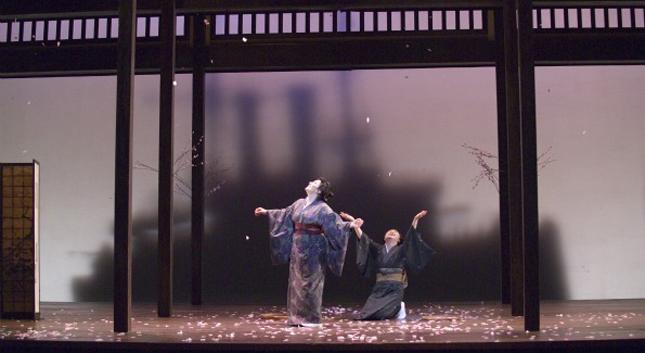Giacomo Puccini’s “Madama Butterfly” is probably the most performed opera in America. The Washington National Opera, with two different casts among the principals, is in the midst of a run of 13 performances for this most romantic and tragic of operas.
There are reasons for that. “Butterfly” is the opera that depends greatly on its music, which sounds like a given for any opera, but it’s especially true here. But it also has in its core the most basic and classical themes of theatrical literature—enduring, undying love and the tragedy that arises from it. And let’s not forget the classic East-Meets-West at the expense of East theme.
Clocking in at roughly three hours with one intermission, “Butterfly” would seem to be a bit of an endurance test for the operatically disinclined, but in the end, it is exactly what it’s often describe as: the opera for people who don’t usually go to the opera. Which accounts for the frequent presence of the opera on the season schedule of any company that can provide the singers, conductors and orchestra to do it justice.
The WNO certainly has that in soprano Catherine Naglestad (Ana Maria Martinez is the second Butterfly), who sings with heartbreaking clarity and acts the part of Cio-Cio-San, aka Madama Butterfly, in an appealing style that avoids overstatement and operatic histrionics that are sometimes off-putting to the uninitiated. Clearly, she’s the unadorned heroine of this opus. She has a beauty that combines with humility to create a young woman already used to the woes of the world but who clings nonetheless to an unfounded hope. Her movements around the stage are graceful without ever descending into Western clichés about Asian ways.
We all probably know the story—Lt. Pinkerton (ably sung by the Russian tenor Alexei Dolgov), a young and caddish American navy officer at the beginning of America’s robust foray into the Pacific, is stationed in Nagasaki, in a Japan where the Shoguns and codes of honor reign. He’s paid for a wife (both marriage and contract can be waived by him at any time), the lovely teenaged Cio-Cio-San, and duly marries her in order to taste as many pleasures as he can before settling down. Cio-Cio-San, forced to become a geisha because of her disgraced father, is smitten beyond reason, commons sense and caution. The feelings are expressed in a lengthy duet in Act One, but it’s Act Two that fills the heart with apprehension, and the soul with a kind of devastating glory.
Pinkerton of course leaves off on the ocean blue, and does not return for three years: Butterfly has been forced to sell off almost everything she has merely to survive, and has also mothered a son, a beautiful small blonde boy. She believes Pinkerton will return to hearth and home. He’s back all right, with an American wife in tow. Pinkerton never sees her, and it’s up to the American consul to relay that news and that the Pinkertons will take care of Cio-Cio-San’s son. Like some bereft waif, left with nothing, Butterfly’s left with an impossible decision.
Butterfly is at her most appealing as she waits, the ship in the harbor, with her son at her side. She has already let us know in thunderous soaring terms in the famous aria “Un Bel Di” (One Beautiful day), which everyone has already heard, if only as muzak in an elevator. She soars with love and hope and as the aria begins, so does the audience soar. You can practically hear a collective sigh move through the audience as the familiar music rises, and the audience soars with her, totally, tearfully satisfied.
This is the kind of thing you don’t often get in theater—satisfaction expressed in the audience, especially when in the presence of a significant artist like Nagelstad
But what you also don’t usually get is what happens next when Butterfly waits, her eyes on the ship, her heart waiting for a sight of Pinkerton, a sound of a footsteps. This sequence has Butterfly with her back to the audience, her heart to the front, and it’s accompanied by quietly powerful orchestral music, a kind of fugue leading to finalized disappointment. Nothing happens: lights change, become muted and bright, go dim on the ship, turn dark in her lanterns. It’s an astonishing sequence that you could never do in the theater, which relies so much on movement and words. You shouldn’t be able to do it in an opera either, but it works. It creates a kind of strain and pain that can only be relieved by the familiar but always shocking tragic ending.
Bene, bene. Bravo Bravo. Ciao, Cio-Cio San.


